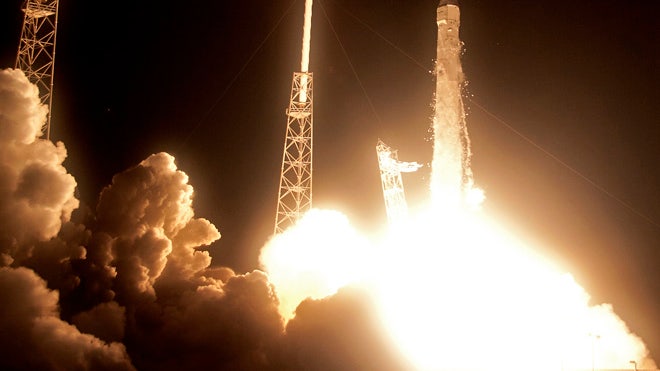SPACE â€"  Space station astronauts have captured the Dragon.
The privately bankrolled Dragon capsule arrived at the International Space Station on Friday, making history as the first commercial delivery truck in orbit. Astronauts Donald Pettit and Andre Kuipers used the space station's robot arm to snare the Dragon after a few hours of extra maneuvering.
'It's a great view ... the solar panels are nicely lit.'
- Dutch astronaut Andre Kuipers, as the Dragon pulled within 900 feet
On Thursday, the capsule came within 1 1/2 miles of the space station in a practice fly-by. It returned to the neighborhood early Friday so Kuipers and U.S. astronaut Donald Pettit could capture it with a robot arm. First, the capsule went through a series of stop-and-go demonstrations to prove it was under good operating control.
NASA ordered extra checks of the Dragon's imagers as the capsule drew ever closer to the space station, putting the entire operation slightly behind schedule. Given that the Dragon is a brand new type of vehicle and this is a test flight, the space agency said it wanted to proceed cautiously.
A collision at orbital speed -- 17,500 mph -- would have been disastrous for the space station.
This is the first time a private company has launched a vessel to the space station, an achievement previously reserved for a small, elite group of government agencies.
President Barack Obama is pushing commercial ventures in orbit so NASA can concentrate on grander destinations like asteroids and Mars. Once companies master supply runs, they hope to tackle astronaut ferry runs.
The California-based SpaceX -- officially known as Space Exploration Technologies Corp. -- is one of several companies vying for the chance to launch Americans from their homeland. That ability ended with NASA's final shuttle flight last summer. To get to the space station, NASA astronauts must go through Russia, an expensive and embarrassing situation for the U.S. after a half-century of orbital self-sufficiency.
SpaceX's billionaire maestro, Elon Musk, who helped create PayPal, said he can have astronauts riding his Dragon capsules to orbit in three or four years. His Falcon 9 rockets lift off from Cape Canaveral, Fla.
Musk monitored Friday's operation from the company's Mission Control in Hawthorne, Calif.
The space station has been relying on Russian, Japanese and European cargo ships ever since the shuttles retired. None of those, however, can bring anything of value back; they're simply loaded with trash and burn up in the atmosphere.
By contrast, the Dragon is designed to safely re-enter the atmosphere, parachuting into the ocean like the Mercury, Gemini and Apollo capsules did back in the 1960s. Assuming all goes well Friday, the space station's six-man crew will release the Dragon next Thursday after filling it with science experiments and equipment.
Article from FOXNEWS







